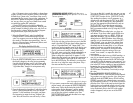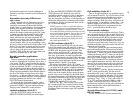THE INTERNAL AND CARTRIDGE MEMORIES
We have already described how to play voices that are
stored
in the internal memories or cartridge
memories.
As part of the tutorial, we have also described how to
store a single voice. The following instructions provide
additional detail on the use of these memories for
storing and rearranging voices. To remain consistent
with the panel labels on the DX7, we use the term
"Store" to describe the process of placing the currently
selected voice (the one which is being played or edited)
into any location (1-32) in the internal or cartridge mem-
ories. We use the term "Save" to describe the process of
simultaneously placing all 32 internal memory voices
into the correspondingly numbered cartridge memories.
We use the term "Load" to describe the process of trans-
ferring the 32 voices from one bank of a ROM cartridge,
or from a RAM cartridge, into the 32 internal memories.
Memory Protect
When you store a voice (or voices) into an internal or
cartridge memory, whatever voice had been in that
memory location is automatically erased... just like
recording new material over an old tape (although
recording tape is not involved). To help you avoid the
frustration and inconvenience of accidentally erasing
any voices, the DX7 is equipped with several types of
Memory Protection. The [MEMORY PROTECT] but-
tons provide independent "software" protection for the
internal and cartridge memories. In addition, the RAM
cartridges themselves have "hardware" memory protect
switches. You can always "read" or "load" a voice from a
memory regardless of memory protect status. However,
you cannot store a voice in any internal memory (or
load the RAM voices into the internal memories) unless
the internal memory protect is first disabled (turned
OFF). Similarly, you cannot store a voice in any internal
memory (or save the 32 internal voices to RAM car-
tridge) unless the cartridge's hardware memory protect
switch is OFF and the DX7's software memory protect-
cartridge feature is also OFF
The following instructions describe the procedure for
turning the memory protect off; they also instruct you to
turn ON the memory protect as soon as the voice(s)
have been stored. It is a good idea to always turn ON
the memory protect unless you specifically need to store
a voice. This habit may someday avoid accidental era-
sure of your voices.
Storing individual voices to
RAM
cartridge
1. First make sure the Memory Protect switch on the
RAM cartridge is turned OFF (switch positioned away
from the connector).
2. Whether you have been playing an internal voice,
editing a voice, or creating one from scratch in the
VOICE INIT mode, turn off the software memory pro-
tect. Press [MEMORY PROTECT-CARTR1DGE],
and the display will indicate "MEMORY PROTECT
CARTRIDGE ???". If "???" is "OFF", the software pro-
tection is already off and you can go directly to Step 3.
If the"???" is "ON", then press the [OFF] button.
3. Press the [MEMORY SELECT-CARTRIDGE] but-
ton, and then press the [STORE] button and hold it
down while pressing the voice selector button (1-32)
which corresponds to the RAM cartridge memory in
which you wish to store the voice. The LCD display
will briefly indicate "Under Writing", and will then
return to the voice name and number, indicating the
voice has been stored.
NOTE: If you attempt this step with either the software
or hardware cartridge memory protection ON, the dis-
play will indicate "MEMORY PROTECTED" as soon
as you press [STORE]. If, when you release
[STORE], the voice name reappears, then the soft-
ware memory protect is ON; perform Step 2 as above,
then Step 3 again. If, when you release [STORE], the
"MEMORY PROTECTED" message remains dis-
played, the hardware protect is ON; perform Step 1,
then Step 3 again.
4. Once the voice is stored, press [MEMORY PRO-
TECT- CARTRIDGE] and [YES] to reactivate the
software memory protection, and then reset the
switch on the RAM cartridge to reactivate its hardware
memory protection.
Saving all 32 internal memory voices
to
RAM
cartridge
1. First make sure the Memory Protect switch on the
cartridge is turned OFF (switch positioned away from
the connector). Then turn off the software memory
protect by pressing [MEMORY PROTECT-CAR-
TRIDGE] followed by [OFF].
2. Press [FUNCTION] to place the DX7 in FUNCTION
mode, and then press [SAVE]. When the display asks
"SAVE MEMORY ALL OF MEMORY?", press [YES]
(unless you change your mind, in which case you
should press [NO] and go on to whatever function
you wish).
3. Because you are about to erase whatever voices are in
the RAM cartridge, the DX7 gives you one more
opportunity to change your mind by asking "SAVE
MEMORY, ARE YOU SURE?" If you indeed want to
save the 32 internal voices in the RAM cartridge,
press [YES] this second time (if not, press [NO]).
4. The display will indicate "SAVE MEMORY, UNDER
WRITING!" for stout 20 seconds as the voices are
being written (saved) onto the cartridge. The display
will then indicated "SAVE MEMORY COMPLETED", at
which point you can select whatever mode you wish
5. Once the 32 voices are saved, press [MEMORY
PROTECT- CARTRIDGE] and [YES] to reactivate
the software memory protection, and then reset the
switch on the RAM cartridge to reactivate its hardware
memory protection.
Loading
all
32
ROM
or
RAM
cartridge
voices to internal memory
1. First turn off the internal memory protect. Press
[MEMORY PROTECT-INTERNAL], and the dis-
play will indicate "MEMORY PROTECT INTERNAL
???". If "???" is "OFF", the internal memory protection
is already off and you can go directly to Step 2. If the
"???" is "ON", then press the [OFF] button.
2. Press [FUNCTION] to place the DX7 in FUNCTION
mode, and then press [LOAD]. When the display
asks "LOAD MEMORY ALL OF MEMORY?", press
[YES] (unless you change your mind, in which case
you should press [NO] and go on to whatever func-
tion you wish). Because you are about to erase what-
ever 32 voices are in the internal memory, the DX7
gives you one more opportunity to change your mind
by asking "LOAD MEMORY, ARE YOU SURE?" If you
indeed want to load the 32 RAM voices into the inter-
nal memory press [YES] this second time (if not,
press [NO]). After a second or so, the message "LOAD
MEMORY COMPLETED" appears, telling you the
voices are loaded.
3. Once the 32 voices are loaded, press [MEMORY
PROTECT- INTERNAL] and [YES] to reactivate
the internal memory protection.
Transfering a single voice from one
location to another in the
RAM
cartridge or internal memory
You may wish to rearrange the voices so they fall in a
particular order as, for example, when you are going to
49


















